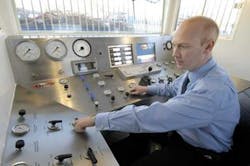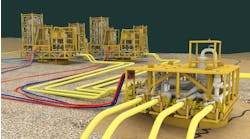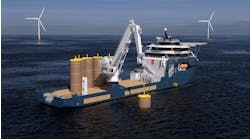The oil and gas industry has used coiled tubing as a well intervention tool since the early 1960s. Since its introduction, the various uses, demands, metallurgy, and the diameter of coiled tubing have changed and/or increased. Driven by demands for higher flow rates as well as larger push and pull forces, the bigger coiled tubing sizes require larger equipment. The simple physical size of the equipment becomes unworkable, particularly for offshore applications.
A few of the roadblocks include:
• Insufficient platform and/or platform crane size
•Available or manageable coiled tubing size cannot access the bottom of the well
• Insufficient pull or push forces and low fluid rates.
The strength of coiled tubing lies in its continuous length of pipe, with no joints and no upsets. Continuous pipe is easy to strip in and out of live wells, even against very high wellhead pressures. It is fast and safe, as it requires no manual operations at the wellhead while tripping.
With the advent of new technologies, the capabilities of small coiled tubing have increased. Some of these advancements are:
•New cleanout technologies permit cleanouts to be conducted with smaller coiled tubing, using less nitrogen and other fluids than previously possible
•New systems allow efficient acidizing with reduced volumes, pumped through small coiled tubing
•New technologies, both mechanical and chemical, can extend the push/pull capabilities of coiled tubing, permitting its use in extended reach wells
•With a 12-ton crane limit, all typical coiled tubing equipment can be lifted onto a platform, including a 1ı-in. coiled tubing string 15,000 ft long using a lightweight power reel
•With an 8-ton limit, typical coiled tubing related equipment can be lifted onto the platform, with the exception of standard 2,000-gal cryogenic nitrogen tanks. Lighter, smaller nitrogen tanks should be used.
Coiled-tubing-deployed electric submersible pumps
An electric submersible pump (ESP) is an artificial lift system that uses an electrically driven downhole pumping system. The pump comprises several staged centrifugal pump sections that can change to suit the production and wellbore characteristics of a given application. Annular flow ESPs are deployed on the coiled tubing with the ESP cable inside the coil, which eliminates the use and retrieval of large bore tubing during the workover process.
Ciaran Dreelan, well services director at Qserv, is at the controls of coiled tubing deployed electric submersible pump services.
In the past few years, the use of coiled-tubing-deployed electric submersible pumps (CT-ESPs) has grown from the first application, with limited design options, to almost a routine service with a variety of deployment options available. Early successful applications in Alaska helped promote the use of CT-ESP in offshore Qatar, West Africa, and the North Sea. Despite this rapid technology evolution, until now the industry has not deployed CT-ESP in the US Gulf of Mexico due to limited candidates. Despite the large GoM shelf well count and long history of producing operations, there are less than 25 ESPs installed in the GoM. Most oil wells in the GoM shelf are gas-lifted because gas lift has lower operations and maintenance cost than ESPs.
BP and BJ Services installed the first CT-ESP in the GoM in 2003. The Grand Isle 40 F-1 well had been producing for several years with 2 7/8-in. jointed tubing. The two previous electric submersible pumps lasted 16 and 30 months. A rig replaced the entire 9,700 ft of production tubing with a 2 3/8-in. coil string that had the ESP at the bottom. The benefits of this deployment method include a reduction in the down time between pump change outs and a reduction in project cost.
Gaining MMS regulatory approval for this project was fairly straightforward. The only significant issue was that this well had been designated a “no-flow” well, which required shooting fluid levels on a regular basis throughout the operation to assure well control.
North Sea deployment
Shifting to the North Sea, Apache has appointed Qserv for the installation of coiled-tubing-deployed electric submersible pump (CTDESP) services.
The investment by the independent oil and gas company is expected to increase well efficiency and reduce the operating costs of its Bravo platform within the Forties field, the largest oilfield ever discovered in the UK sector of the North Sea. The company will use ESPs to produce fluids from the reservoir. The ESPs will also be the driving force to transfer these fluids to the neighboring Charlie platform. They will then be processed through Charlie’s production systems, eliminating the requirement for production systems on the Bravo platform.
Qserv used the ESP technology in other regions such as Qatar, where the service company changed the process of well workover. The ESP configuration differs when compared to conventional systems and is deployed on 2 3/8-in. coiled tubing, with the ESP power cable and umbilical lines inside the coiled tubing. Qserv inverted the ESPs, which use a bottom intake to produce the fluids up the annulus to the coiled tubing, negating the requirement for large bore deployment tubulars.
Qserv completed a contract involving 28 CTDESP high performance well installations and workovers for Anadarko in Qatar. Ken Hood, ESP engineer for Anadarko, commented on his experience: “Our overall economics have improved through the company’s concentration on safety, an ability to manage the workovers, teamwork with other vendors, and innovative engineering techniques. The company has delivered against its commitments and this has reduced our lost production by half, allowing us to reduce costs and maintain well production in our already marginal field.”
Through this track record of 28 CTDESP wells completed in the past 18 months with Anadarko, Apache recognized an obvious benefit. Apache North Sea can use this and other technology to reduce operating costs and increase well production uptime in the Forties field.




